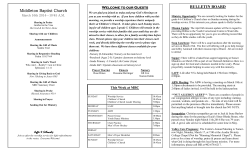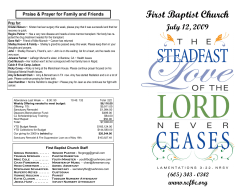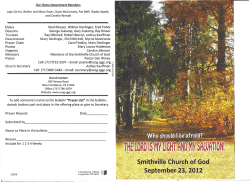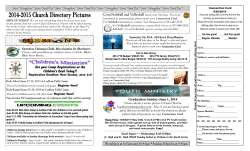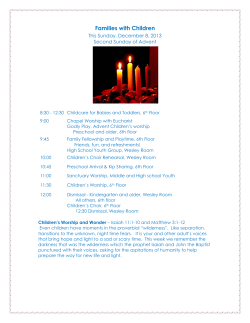
Training Extra 7 Worship, the under-5s way
Training Extra 7 Worship, the under-5s way In the church, the adult worship is in full swing. As the congregation sings, they raise their arms to God; some clap and others dance, although restricted by the pews. The mood shifts to something more reflective and some choose to kneel during the singing. The people are completely focussed on worshipping God. They have stopped thinking of what other people think and the music fills the building. In a side room of the same church building, the under-5s group sit, while their adult leaders sing a complex song, with the old piano jangling. The children fidget, bored. They don’t know or understand the words, and they don’t have anything to do. Some get up and wander away – the toys are much more attractive! The children are not thinking about God, but are waiting for the adults to finish so they can have a drink and a biscuit. How can a church, where adult worship is well developed and varied and is inspired to enable everyone to reach God, help their young children to worship? Alison Dayer is an Under-5s specialist and Evangelist for Bedfordshire, Buckinghamshire, Cambridgeshire, Hertfordshire and Northamptonshire for Scripture Union England and Wales. She has a wealth of experience of working with 5s and under. Here she helps us discover that worship is more than singing – and that under-5s can worship God in their own unique way. What is worship? Worship is always God-focussed. The origin of the word is ‘worth-ship’. In other words, worshipping means showing how much you value something or someone. For Christians, worship means showing God how much we love and value him. In our churches, we often relate worship only to the singing time, but worship (for any age) is more than that. It is the words we speak, the prayers we say, the music we listen to, the way we sit or stand, the way we dance or move. It is all that we do, that is God-focussed. And that applies to the under-5s, just as much as to the adults. So, for our under-5s, what can we use to help them worship? For this article we will look at four areas – music, movement, singing and prayer – not a definitive list, but a useful one to start with. Music When we use music in church, we usually sing to it, but we can also listen to it. Music creates a particular atmosphere and young children are very receptive to this. Playing a quiet piece of music, whether it has lyrics or not, can help children focus on a prayer or a story and can add depth to the experience. Playing a short piece of reflective music can also allow children to have a short, quiet time of reflection. (Don’t try to make this long as their attention and concentration spans are very short – one or two minutes is plenty!) Playing music can also aid other responses, such as drawing and movement. But how do you know which music to choose? Choosing appropriate music is important. Music for young children needs to be fairly simple with a simple melody and arrangement. Heavily orchestrated and multi-layered music is too much for young children and they will be unable to focus. But be careful not to choose oversimplified music as this won’t catch their attention well. Use pieces that are fairly short. Any piece will need to sound complete in a short section. If the music has repeated phrases, the children will pick these up quickly and enjoy anticipating them. You don’t need a huge library of music for this – just one or two tracks are sufficient and will last many weeks. Have a look at the Baby Einstein range of music; visit www.babyeinstein.co.uk to see the range. The short musical tracks are specifically arranged for young children including classical and traditional favourites. You may well find that, if you use the same music each time you ask the children to participate in a reflective activity, they will come to respond appropriately with the music as a cue to help them into this style of worship. Don’t worry that the children won’t know what to expect, if they don’t respond well the first few times. Begin with just a few seconds and gradually increase the time you spend in reflective activities. You may find it helpful to use an active listening approach early on, Building Blocks © CATS 2009 PAGE G1 such as drawing or movement, as they will have something to focus them. Encourage them to be quiet, speaking yourself in a quiet voice – they will have to be quiet to hear you! Using percussion instruments is great fun for the children and for the adults, if they are brave! The children will enjoy using them to accompany music or songs. They can also provide a non-verbal way for the children to express emotions or ideas. The children will need time to play with the instruments before you can use them productively in worship. They need to explore what sounds the instruments can make and get over the novelty. It may take several sessions of play, before you can actually use them for worship. Try this activity 1 Teach the children a simple stop signal. For example: say ‘Stop’ as you move your hand sharply across your body with the palm towards the children. Practise this! 2 Spend some time asking the children to make different types of sounds, such as happy or sad sounds, to show different feelings. Tell the children that they are going to use the instruments to show God how they feel. 3 Tell them to listen carefully to the prayer and use the instruments to show God how they agree with it. “Dear God we are sorry for all the wrong things we do. We are sorry for hurting people. (Give the children time to play their sad sounds.) Thank you for all the wonderful things you have given us – families, friends, the warm sunshine and beautiful plants.” (Give the children time to play their happy sounds.) Movement When adults worship, they usually stand to sing, but may choose to kneel or sit for certain songs. Usually they sit or kneel for prayer but many adults prefer to move – to walk around – particularly when they are on their own. The posture they use helps them to respond more effectively to the type of worship. Children are just the same. Whether we ask children to sit or stand or move makes a difference. Sitting will help a child to be quiet and more reflective. There are fewer distractions and it is easier to be still for a short time. But standing allows the children to be more active and use movement, which is great for action songs. But the children are more likely to be distracted and fidgety. Many of the songs we sing with young children are ideal for using actions. This can mean that the children don’t need to learn the words. Children who are non-verbal (whether that is because of their age, special need or shyness) can be involved. If you use Makaton signs, children with learning difficulties will be fully involved. Find out more about Makaton at www.makaton.org Actions and signs can be very expressive when chosen carefully, and may help understanding when used to illustrate more difficult concepts. The fact that you use actions provides a visual stimulus for the children as well as an aural one. And when the children join in they have the physical stimulus to help them concentrate. Often we use actions for songs, but we can also use them for prayers, allowing non-verbal children who cannot write or draw to join in and express their emotions. When teaching a new action song, teach the words and actions separately. Encourage the children to join in with the actions as you say the words and then use the actions as you sing the song. Don’t try to use too many actions. Choose the key ones for each phrase and the ones that will be repeated during the song. Teach the words on another occasion. Dancing allows the children to use their whole bodies to express their feelings. Few adults dance in worship, although King David famously did so (2 Samuel 6:14), but children are much more natural about this. Putting on a piece of worship music, asking the children to listen to it and then dance to show how it makes them feel, allows them freedom to respond to God. Dance can also be used as a response to Bible stories or teachings and during prayer times. Small flags or streamers will allow a range of movement and can often encourage the most reticent child to begin moving. The children need time to play with flags and streamers. They need to explore what they Building Blocks © CATS 2009 PAGE G2 can do with them and feel confident about how to use them. Spend some time showing them ideas of different movements and allow them enough opportunities when the novelty factor dies down. Singing This is the aspect that comes to mind first, whenever we talk about worship. We are always keen to ensure that the quality of our worship is good. This applies to under-5s just as much as to older children and adults. So we need to make sure that we provide quality songs to be used in their worship. When choosing songs, there are several things to consider. Make sure that the songs are theologically sound. Everyone learns a great deal of their understanding of God and the Bible (their theology) from what they sing. It is important that the children don’t learn something from a song that they will need to unlearn later. Choose songs that use Biblical truths and focus on God. Remember too, that young children need words and concepts that are suitable and understandable. New words and concepts can be introduced through songs. Explain them first to the children which will help them to move forward. Too many difficult ideas and words will stop them understanding. Be aware too, that under-5s are very literal, so think carefully about non-literal images. For a young child, Christian jargon about asking Jesus into our hearts or being washed in blood can be confusing and even frightening. As for music itself, songs need to have a fairly simple melody and rhythm. Children have quite a narrow singing range (those that can sing in tune!) and cannot make lots of jumps in pitch. If the tune is too complex, the children will get lost. Fast songs can be great fun, but the children need to be able to keep up, whilst songs that are too slow will bore them. Many songs written especially for young children make good use of repetition, allowing the children to join in easily and feel secure. If you are using songs for worship time (rather than just for fun singing time), then ask yourself the question: ‘Is this worship?’ Worship needs to be God-focussed. There are lots of good children’s worship songs, and also lots of fun Christian songs, which are not ideal for worship. As you read the words, ask these questions: • Does it show God how much we love him? • Does it talk to God? • Does it state truths about God? • Does it praise the attributes of his character? • Does it act as a response to God or the Bible? If you can answer ‘yes’ to any of these questions, then it is right to use this song for worship. If you can’t, then a worship time is not the place for this song. There are other times to use it. Try this activity 1 Spend some time looking at your own adult Christian music collection. Which albums and songs are for worship? Others are songs written from a Christian perspective and reflect a Christian lifestyle and a Christian response to issues. Which help you to worship God? 2 Now look at your collection of children’s Christian music. Which of these are worship and which are songs written from a Christian perspective. Which will help the children worship God? Choosing your accompaniment to singing can be a worry. Singing with just voices (a cappella) is the simplest option. If you sing with enthusiasm and confidence (even if you don’t feel it), the children will follow. They won’t notice if you are tuneless! Having a go can be very freeing and may be much better than poor leading from a musician or CD. Musicians can be a great resource to lead your under-5s worship. Make sure that they keep the speed of the music down (without dragging) and that it is simply performed. Most musicians will need to concentrate on their playing, so someone else will need to lead the Building Blocks © CATS 2009 PAGE G3 singing and the actions. If the musician is very good they may be able to lead the singing, but they cannot do actions as well as play an instrument, so someone else must do this. If your musician is good and aware of the children’s needs, then you can have a brilliant time. If they are not good musically or are unaware of the children’s needs, then it can be a disaster. You’re better off saying, ‘Thank you, but no thank you.’ Compact disks have made life much easier for children’s leaders. Music and a tuneful lead voice give volume and a bit of ‘oomph’ to your singing. But you do need to be selective. Some CDs, although sold as suitable for under-5s, are not. The music and words may be too complex. (Some well known children’s worship leaders simplify their arrangements of songs written for older children resulting in the music being unexciting and the words too difficult.) Some CDs are too simple and can be ‘twee’! If you can, listen to a CD before you buy it. Look for CDs specifically produced for under-5s from groups known for their expertise in this work (not just children’s work) – such as Spring Harvest and New Wine. When playing CD tracks, think flexibly. Think about what you can do during a musical interval – dance, tell someone God loves them, do the actions without words. If you feel the track goes on too long, then turn it off at a suitable place, perhaps reducing the volume as you do so in order to maintain the atmosphere. “When I first started leading an under-5s group I had two musicians offer their help. The pianist banged out the songs with gusto and the children couldn’t keep up. The guitarist never prepared and on one occasion tried to work out the chords as the children waited. I decided to manage without. From then on we sang unaccompanied and had great fun worshipping God, although I’m tone-deaf and cannot hold a tune!” Choosing which songs to use in a worship sessions is important. Always try to have a mixture of familiar songs and new ones. The familiar songs will make the children feel secure and confident and help them worship. Whenever possible, introduce only one song in any session, teaching it carefully (actions first, then words) and try to repeat it later in your worship time. Allowing the children to choose which songs to sing is great for helping them respond and feel involved. But don’t overdo this, as you need to be their worship leader and help them to worship God. Link your worship to the theme of the day wherever possible, so that the worship grows out of the teaching. Having several general songs in your repertoire would help this. Over a period of time, such as a term, choose a small number of songs that fit the themes and repeat them often. A small repertoire of five or six songs allows the children to be familiar with the songs, giving them the freedom to concentrate on worship rather than concentrating on remembering the words and actions. Include a mix of quiet reflective songs and more active ones, so that you can calm the atmosphere or raise the excitement, in order that the children can respond to God appropriately. Above all, make sure that you know the songs yourself! Other adults can have the words available on a screen or in a booklet so that they can join in. However, the leader needs to be confident and lead, whilst keeping eye contact with the children and having the freedom to use the actions properly. Remember the children will copy you. If you do actions one-handed because you are holding the sheet with the words, then the children will do one-handed actions as well! Prayer Prayer is simply another name for communicating with God. Any method that children can use to communicate can be used for prayer. Don’t be afraid that children won’t say anything. With space, encouragement and experience, children can be amazing in their prayers. They get straight to the point and expect God to answer! Encourage children to pray, using various forms. Try different methods in order to encourage all the children to find a way that suits them and to keep prayer fresh. If you use one style for a few weeks the children will grow in confidence as you model prayer and give them space to try it for themselves. Using music will enable songs to be used as prayers or as a background to set the mood; instruments can be used to express feelings. “During a prayer and worship time we were praying for children around the world. We talked about children without clean drinking water. Kim prayed, ‘Dear Jesus, thank you for water. Please help children who have dirty water to have clean water and not get ill. Amen.’ What else needed to be said?!” Most prayers in church are spoken and, with confidence, young children can pray freely. Start them off with one-word prayers, such as, “Thank you God for…” Children love to use different volumes, so whispered and shouted prayers will involve them. Try choosing a simple phrase to be repeated; start in a whisper and gradually increase the volume, until it is shouted out. Don’t forget that the children can pray silently for a very short time. This allows them some privacy in their relationship with God and encourages them to listen to God. Quiet music can help this be less oppressive and mask outside noises. Building Blocks © CATS 2009 PAGE G4 Older under-5s will be able to draw their prayers which can be kept private or displayed as a group prayer. It does not matter if the adults cannot recognise the drawings. The children are not communicating with them, but with God and he is big enough to know what they have drawn! Many adults remember learning prayers as a child. (Can you complete this? ‘Thank you for the world so sweet, …’) There is value in doing this, as it models prayer. You could also teach the children a short phrase which can be used as a response, whilst the adult leads the prayers. If you have an active group, you may have difficulty getting them to sit still, so harness their energy by using dance or actions to pray or have simple prayerstations around the room. “But how do I get their attention?” This is a frequent cry from many people with a group of lively young children. There are plenty of ways to do this. For example, going straight from another activity, such as singing or a story can make this much easier. The old classic of “hands together, eyes closed” has its place. It reduces distractions and can create a good atmosphere. You could also try holding hands in a circle or praying with hands outstretched or raised. A prayer drill involves a short series of actions which get the children’s attention and can focus them. For example: Shake out the fidgets (shake hands and legs), reach up to get God’s attention (reach up like a child grabbing a parent’s hand), and bring his hand down to your heart (bring hand down clenched to chest). Using a picture or an object as a focus of attention (especially if it is linked to your theme), can also provide a stimulus for prayer. Knowing what to pray about can be worrying for leaders. Using the TSP format (Thank you, Sorry, Please) is good on occasions, but needs to allow space for the children to be involved. Pictures and objects related to your theme can help prompt the children. You could put pictures between the pages of the Bible for the children to open up and then pray, or put them into a bag and draw out one at a time, or place them around the room for children to go to and pray independently. It is important that we teach the children that prayer is not a ‘wish list’ to God. Encourage the children to listen to God and expect him to communicate with them. Use music, pictures or your voice to create the atmosphere for short quiet times when the children can be aware of God talking to them. What will good worship do for the children? If we give the children quality worship opportunities, what will be the benefits? Worship will enable the children to develop their relationship with God and give them opportunities to express their feelings about God. Worship which connects with the theme of the teaching reinforces the learning and gives them a chance to respond. It helps them to relate the learning to their lives through their responses and prayers. None of these ideas are rocket science. Some of them are easy and some take courage from the leaders. Many will gain in effectiveness as the children get used to them and grow in their experience and confidence in worship. Under-5s deserve the chance to worship God and he revels in their worship. “From the lips of children and infants you have ordained praise.” Psalm 8:2. Go and be inspired by their unrestrained love for God! Building Blocks © CATS 2009 Training extras Find further products to help you worship the under-5s way in TRAINING EXTRAS Resource bank © 2008 Scripture Union, used by permission PAGE G5
© Copyright 2025

